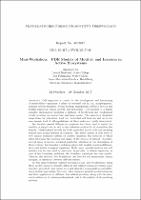Zusammenfassung
Cell migration is crucial for the development and functioning of multicellular organisms; it plays an essential role in, e.g., morphogenesis, immune system dynamics, wound healing, angiogenesis, bacterial motion and biofilm formation, tumor growth and metastasis. Cell motility is a highly complex phenomenon involving a plethora of biophysical and biochemical events occuring on several time and space scales. The associated dynamics range from the subcellular level over individual cell behavior and up to the macroscopic level of cell populations; all these scales are tightly interrelated.
For decades, partial differential equations have been used to model the motility of single cells as well as the collective motion of cell assemblies like tumors. Mathematical models for both individual motile cells and invading tumors have major features in common. The active nature of cells leads to very similar nonlinear systems of coupled equations, the solutions of which often determine the position and shape of the objects of interest. Recently, several types of models attracted particular attention in the description of these systems: free boundary problems, phase field models, reaction-diffusion-taxis and kinetic transport equations. Both tumor growth/invasion and cell motility can be described by parabolic, hyperbolic, or elliptic equations; in case of free boundary problems, the boundary conditions are very similar. Thereby, the involved free boundaries can describe cell membranes, tumor margins, or interfaces between different tissues.
In this mini-workshop applied mathematicians and biophysicists using these model classes to describe different but related biological systems came together, presented their recent work and identified commonalities and differences in their approaches. Moreover, they discussed possible model extensions and their application to different, but related problems, along with the innovative utilization of certain mathematical tools to the analysis of the resulting systems.

